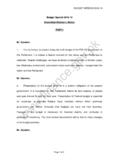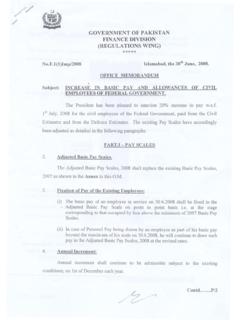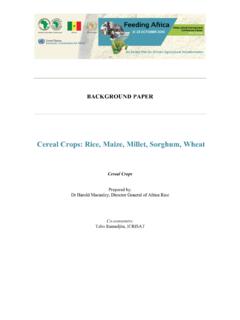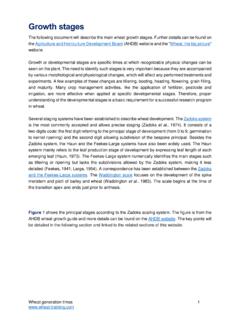Transcription of Agriculture - Finance
1 Agricultural sector is indispensable to the country s economic growth , food security, employment generation and poverty alleviation particularly, at the rural level. It contributes percent to the GDP and provides employment to around percent of the labour force. More than 65-70 percent of the population depends on Agriculture for its livelihood. Agricultural growth rate has been constrained by shrinking arable land, climate change, water shortages, and large-scale population and labour shift from rural to urban areas. Increasing agricultural productivity, therefore, requires adoption of new approaches. With strong forward and backward linkages with the secondary (industrial) and tertiary (services) sectors, it can play a pivotal role to spur economic growth . However, this sector has remained prone to several challenges like climate change, variance in temperature, water shortage, and changes in pattern of precipitation along with increase in input prices.
2 The government is closely monitoring key crops and devising policies/planning interventions to ensure uninterrupted supply of basic food items at affordable prices in the country. The primary goal of the government is to enhance financial inclusion in the Agriculture sector to boost productivity and exports, thereby enabling a rural development-driven economic growth . Realising the importance of Agriculture , the government is also focusing on pro- Agriculture set of policies to tap maximum benefits by introducing the agri-input regime to increase yields of major rabi and kharif crops. The Prime Minister has approved Agriculture Transformation Plan with the objective to enhance national agricultural output and livelihood of farmers. Box Item-I: Agriculture Transformation Plan Ministry of National Food Security and Research presented an action plan before Prime Minister for transformation of Agriculture sector in the country.
3 Under this plan provinces will work on re-tweaking of machinery given under National Agriculture Emergency Projects (NAEP) on wheat , rice, sugarcane, and oilseeds for maximum distribution of implements among farming community on following aspect: Design of intervention and pre-qualification mechanism Additional implements Subsidy mechanism to be aligned with Kissan Card Service providers to be registered Unique implement ID Farmers share Agriculture Chapter 2 Pakistan Economic Survey 2020-21 18 This approved action plan with specific timeline for interventions, yield gaps and particular issues of the sector to be resolved through first and second generation. These interventions comprise of action to be taken by Federal and Provincial Governments. The details are as under: First Generation Interventions Bridging the yield gap Target sectors Seed sector reforms Inputs: digital subsidy mechanism Mechanization Water efficiency Revamping extension services Access to credit Post harvest storage Restructuring research institutes Cotton revival Olive deepening Genetic improvement in livestock Fisheries Second Generation Interventions Horizontal expansion International Cooperation Value Chain Development Clusters (Fruit & Vegetables) Perishable produce Crop Zoning Land Consolidation Organic farming Adaption and self-discovery Sub-montane Agriculture Source: Ministry of National Food Security & Research Agriculture Performance during 2020-21 Pakistan has two cropping seasons.
4 Kharif , the first sowing season, which starts from April to June and is harvested from October to December. This season crop cycle mainly consists of rice, sugarcane, cotton, maize, moong, mash, bajra and jowar. "Rabi", being the second season, sowing begins from October to December and is harvested from April to May. It comprises mainly of wheat , gram, lentil (masoor), tobacco, rapeseed, barley and mustard. The Agriculture sector s performance during 2020-21 broadly stands encouraging as it grows by percent against the target of percent. The growth of important crops ( wheat , rice, sugarcane, maize and cotton) during the year is percent. The production of major Kharif crops 2020, such as sugarcane, maize and rice indicated considerable improvement compared to last year and surpassed the production targets. The production of sugarcane increased by percent to million tonnes from million tonnes, rice by percent to million tonnes from million tonnes and maize by percent to million tonnes from million tonnes.
5 However, the cotton crop suffered mainly due to decline in area sown, heavy monsoon rains and pest attacks. The cotton production reduced by percent, to million bales from million bales last year. wheat , the most important crop of Rabi , showed a growth of percent and reached record high production level of million tonnes compared to million tonnes last year. The wheat cultivation area increased to million hectares prompted by record domestic prices and official programmes promoting wheat production. For the Rabi crops 2020-21, the government provided a comprehensive Agriculture 19 Rabi Package comprising of subsidies on fertilizer, fungicides and weedicides, together with an increase in the Minimum Support Price (MSP) of wheat to Rs 1,800 per 40 Kg. Other crops, having a share of percent in Agriculture value addition and percent in GDP, showed growth of percent because of increase in production of fodder, vegetables and fruits.
6 Cotton ginning declined by percent due to fall in production of cotton crop. The overall crops sector, having a share of percent in Agriculture value addition and percent in GDP witnessed a growth of percent due to increase in growth of important crops by percent. This was largely due to sufficient availability of agricultural inputs (water, subsidized fertilizers, certified seeds, pesticides and Agriculture credit). Livestock having a share of percent in Agriculture and percent in GDP achieved a growth of percent. The fishing sector, with a share of percent in Agriculture value addition and percent in GDP, grew by percent, while forestry sector having share of percent in Agriculture and percent in GDP grew by percent. (Table ) Table : Agriculture growth (Base=2005-06) (%) Sector FY2015 FY2016 FY2017 FY2018 FY2019 FY2020 FY2021 P Agriculture (i+ii+iii) i) Important Crops ii) Other Crops iii) Cotton Ginning P: Provisional Source: Pakistan Bureau of Statistics Water availability during Kharif 2020 remained at million acre feet (MAF) showing a slight decrease of percent compared to MAF of Kharif 2019.
7 Rabi season 2020-21 received MAF, showing an increase of percent over Rabi 2019-20. (Table ). Table : Actual Surface Water Availability (Million Acre Feet) Period Kharif Rabi Total % age increase/decrease over the average system usage ( MAF) Average system usage - 2011-12 2012-13 2013-14 2014-15 2015-16 2016-17 2017-18 2018-19 2019-20 2020-21 Source: Indus River System Authority Pakistan Economic Survey 2020-21 20 I. Crop Situation The important crops contribute percent to value addition in Agriculture sector and percent to GDP. Other crops account for percent in value addition of Agriculture sector and percent in GDP. The production of important crops is given in Table Table : Production of Important Crops (000 Tonnes) Year Cotton (000 bales) Sugarcane Rice Maize wheat 2014-15 13,960 62,826 7,003 4,937 25,086 - - - - - 2015-16 9,917 65,482 6,801 5,271 25,633 ( ) ( ) ( ) ( ) ( ) 2016-17 10,671 75,482 6,849 6,134 26,674 ( ) ( ) ( ) ( ) ( ) 2017-18 11,946 83,333 7,450 5,902 25,076 ( ) ( ) ( ) ( ) ( ) 2018-19 9,861 67,174 7,202 6,826 24,349 ( ) ( ) ( ) ( ) ( ) 2019-20 9,148 66,380 7,414 7,883 25,248 ( ) ( ) ( ) ( ) ( ) 2020-21(P) 7,064 81,009 8,419 8,465 27,293 ( ) ( ) ( ) ( ) ( ) P: Provisional Note: Figures in parentheses are growth /decline rates Source: Pakistan Bureau of Statistics a) Important Crops i) Cotton Cotton crop stands vital in Agriculture as well as textile sector of the economy.
8 It contributes around percent to GDP and percent of the value added in Agriculture . Cotton crop faces multiple challenges and competes with other crops especially sugarcane. International prices also play a role. Being an export oriented raw material of textile industries, maintaining prices at levels competitive with the international market while ensuring due profitability of growers has been a great challenge for policy makers. During 2020-21, the crop was cultivated on 2,079 thousand hectares, reflecting a contraction of percent as compared to last year s sown area of 2,517 thousand hectares. Production declined by percent to million bales against production of million bales last year (Table and Figure ). Declining cultivated area has 1067111946986191487064600070008000900010 0001100012000 2016-17 2017-18 2018-19 2019-20 2020-21(P) : Cotton Production (000 bales) Agriculture 21 reduced production as the crop has lost its competitiveness relative to other major crops, in particular sugarcane.
9 Table : Area, Production and Yield of Cotton Year Area Production Yield (000 Hectare) % Change (000 Bales) % Change (Kgs/Hec) % Change 2016-17 2,489 - 10,671 - 729 - 2017-18 2,700 11,946 753 2018-19 2,373 9,861 707 2019-20 2,517 9,148 618 2020-21(P) 2,079 7,064 578 P: Provisional Source: Pakistan Bureau of Statistics Box Item-II : Cotton Crop: Challenges and Way Forward Pakistan, a major producer of cotton (ranked 5th, ICAC), is facing a significant decline in major varieties of cotton crop production due to multiple challenges. Acreage of cotton crop is shrinking due to non-profitability of the crop as compared to maize, paddy and sugarcane. Other factors contributing to the decline are i) biotic stresses of white fly and pink bollworm, ii) abiotic stresses like climate change, heat stresses and extreme rainfalls iii) poor agricultural practices and unnecessary use of pesticides.
10 A high cost of inputs including fertilizers, pesticides and seeds is another area of concern. There is lack of early generation seed and research progression is inadequate for development of new varieties which can withstand pests, diseases, and climatic stresses. Research experts suggest that cotton zoning is indispensable to revive the crop. Such zoning coupled with fixation of minimum indicative or intervention price, timely issuance of subsidies and improved extension services for awareness of farmers are essential for revival of cotton production. A ray of hope in this regard is a fact that government institutions are gearing up to boost production of the strategic crop which involves livelihood of millions of farmers and related industries. To start with, M/o NFS&R has initiated an Agriculture Transformation Plan including amending relevant laws to fast track release of new cotton varieties with novel technologies.















